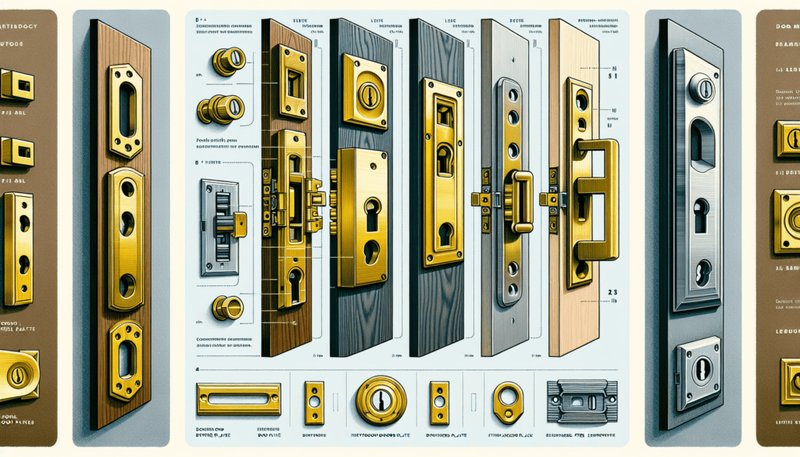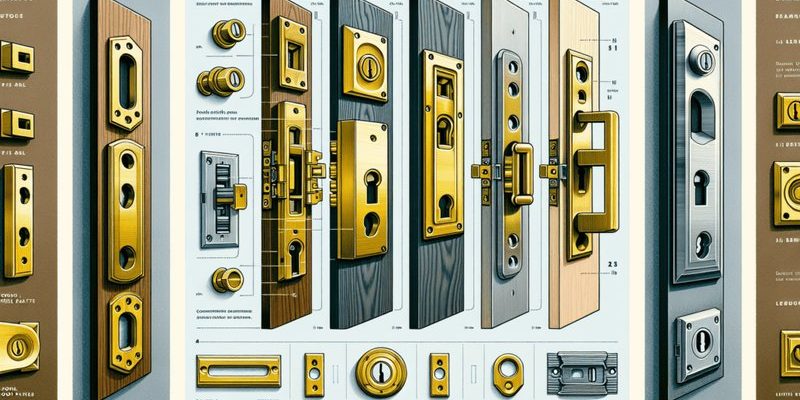
So, what’s the deal with strike plates? Simply put, a strike plate is a metal plate installed on the door frame, allowing the bolt or latch from your door lock to fit snugly into place. Depending on the latch style you have—whether it’s a simple deadbolt, a mortise lock, or something more intricate—the type of strike plate you need can vary significantly. Let’s dive into the different types of strike plates and see which ones work best for various door latch styles.
Understanding Strike Plates
Before we get into the nitty-gritty, it’s essential to understand what a strike plate does. Imagine your door latch as the key player in a game; the strike plate is its goalpost. Without a goalpost, scoring an easy shot wouldn’t be possible. The strike plate reinforces the area around your latch, making it much harder for anyone to pry open the door.
There are two main types of strike plates: round and square. Round plates usually accompany cylindrical locks, while square plates often pair with deadbolts. Choosing the right one isn’t just about looks; it’s about functionality and security.
Types of Strike Plates
When selecting a strike plate, you’ll often find a few variations. Let’s break them down:
1. Standard Strike Plates
Standard strike plates are the most common type. They’re usually rectangular and designed to work with basic latch styles. If you’ve got a standard knob lock on your door, a standard strike plate is likely what you need.
These plates are typically made from brass or stainless steel, making them durable. For a standard installation, you just need to screw it into the door frame. But here’s the thing: they might not provide the additional reinforcement that heavy-duty latches require.
2. Deadbolt Strike Plates
If you’re using a deadbolt, you’ll need a deadbolt strike plate. These plates are usually larger and can accommodate a longer bolt, offering extra security. Think of it as an upgrade to your door’s defense system—it’s not just about being locked; it’s about being locked securely.
Deadbolt strike plates often come with an extra feature: a lip that extends downward. This design prevents someone from easily prying the door open, making it ideal for external doors. Plus, many deadbolt strike plates are customizable, allowing you to tailor them to your specific latch.
3. Mortise Strike Plates
Mortise locks are a bit more specialized—they require a unique strike plate designed for the mortise style. Mortise locks sit inside the door, making them less visible and more secure. The corresponding strike plate is usually more complex, often featuring a larger cut-out to accommodate the lock’s mechanism.
If you’ve got a mortise lock, this type of strike plate is essential for ensuring proper alignment and security. Using the wrong plate can lead to malfunctioning locks, which is the last thing you want in your home.
Choosing the Right Material
Material matters when it comes to strike plates. The strength and durability of the plate can affect your door’s overall security.
1. Brass Strike Plates
Brass is a popular choice for strike plates, thanks to its corrosion resistance and aesthetic appeal. However, it can be softer than other metals, meaning it could bend or deform under pressure—definitely not ideal for high-security needs.
2. Stainless Steel Strike Plates
If you want robust security, go for stainless steel. These plates are incredibly strong and resistant to wear and tear. They hold up remarkably well against attempted break-ins, making them a great option for outside doors.
3. Aluminum Strike Plates
While aluminum is lightweight and cost-effective, it may not offer the best security. It’s a good choice for interior doors or for those on a budget, but if you’re looking for high security, stick with either brass or stainless steel.
Installation and Adjustment Tips
Installing a strike plate can seem daunting, but it’s pretty straightforward if you take it step by step. Here are a few tips to make the process easier:
1. Measure Carefully
Before you start, measure both the strike plate and the door latch. You want to ensure everything lines up perfectly. If your strike plate doesn’t match up neatly with your latch, it can lead to frustration.
2. Use the Right Tools
You’ll typically need a screwdriver and a drill for installation. Make sure to have these on hand before you begin. Using a power drill can speed up the process, especially for tougher materials.
3. Test the Fit
Once installed, test the latch to ensure it effortlessly engages with the strike plate. If it sticks or doesn’t align, you may need to adjust the plate or even the latch itself. A little tweaking can go a long way.
Common Issues and Solutions
Even with the best strike plate, you might run into problems. Here are some common issues and how to tackle them:
1. Misalignment
If your door latch doesn’t align with the strike plate, first check the door hinges. Sometimes, tightening or adjusting hinges can solve the issue. If not, you may need to reposition the strike plate.
2. Wear and Tear
Over time, strike plates can become worn. If you notice rust or bending, it’s time for a replacement. Regularly inspecting them can help catch these issues early.
3. Security Weakness
If your home feels less secure, consider upgrading to a more durable strike plate or adding additional security measures. This could mean installing a reinforced strike plate or combining it with deadbolts for extra protection.
Choosing the right strike plate for your door latch style is more important than it might seem. It’s all about finding the right balance between security and functionality. Whether you opt for a standard, deadbolt, or mortise strike plate, make sure it suits your specific needs. Taking the time to install the right plate can make your home feel a lot safer, keeping unwanted visitors out. Remember, a little investment in your door hardware goes a long way toward protecting your home sweet home.
